Genetics
A-locus
4. A - Agouti
A is the nonmutated wild type "basic" gene of the a-locus. It is dominant over a (am and ae, but recessive to Ay, Avy and Aw. It is partially dominant over and partially recessive to at.
The agouti gene A is the so-called wild type coloration, causing a pigmentation where each hair has "banded" hairs - that is, yellow (again, in the genetical sense!) band on an otherwise black hair. Typical to agouti colours is this banding and ticking - intermingling of black guard hairs - in the coat. In colours that have one or more diluting genes (b, d, p etc), the colours present in the agouti coat are diluted in accordance to the effect of each gene.
In the mouse fancy, this basic banded pattern on the mouse's hair has been fine-tuned to give somewhat different effects with differing genotypes. This is reflected (and sometimes somewhat exaggerated) in show standards.
Standardized or "on the way to standardization" varieties with this gene are agouti, cinnamon, argente, chinchilla, grey agouti and argente creme, blue agouti and lilac agouti, as well as agouti tan and cinnamon tan.
4.1. Homozygous Forms
All agouti-form colours with belly colours matching the top are either homozygous A/A mice or heterozygous A/a mice due to full dominance of A. These forms are discussed here and not separately in section "4.2. Heterozygous Forms".
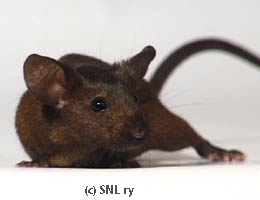
Agouti, A/* B/* C/* D/* P/* |
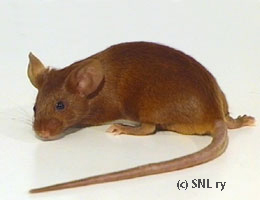
Cinnamon, A/* bc/* C/* D/* P/* |
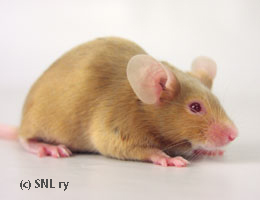
Argente, A/* B/* C/* D/* p/p |
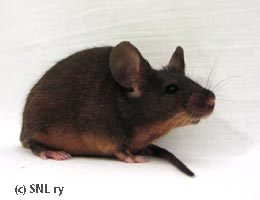
Agouti tan, A/at B/* C/* D/* P/* |
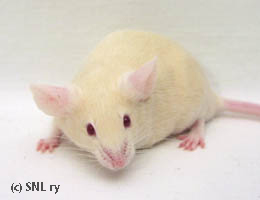
Argente creme, A/* cch/cch p/p |
4.1.1. Agouti
The genotype of an agouti mouse is A/* B/* C/* D/* P/*, also referred to as "black agouti". In old fanciers' texts, this is called "golden agouti".
Even though agouti is "the" basic colour of the mouse, being the wild type colour, current agouti fancy mice look quite different from their wild cousins. After well over a hundred years of selective breeding, the agouti has become a rich, vivid, deep colour. The "yellow" band on the mouse's hair should be rich brown or golden in shade. The black / almost black tip and base of the hair have been bred to be quite narrow, making the rich brown as the dominant colour on the mouse. Compared to the wild mouse, the ticking of the agouti fancy mouse is of the same black colour, but bred to be very even and pleasing to the eye.
4.1.2. Other Homozygous Forms
Genetically speaking, other A/* varieties would include chocolate, blue and chocolate & blue (= lilac) dilutions of the pink-eyed agouti (Argente); the same dilutions of the chinchillated agouti (grey agouti); pink-eyed chinchillated agouti (not in standards - argente creme with belly to match top) and chocolate, blue and lilac dilutions of this colour.
With the addition of other c-locus recessives besides cch, even more colours are possible (but very seldom recognized as stand-alone varieties and standardized, as they usually aren't considered worthy of standardizing).
4.2. Heterozygous Forms
When A is heterozygous with higher a-locus genes, it's effect is hidden (except in the striping colour in Avy/A Brindles). With lower a-locus genes, A is fully dominant. There's one very interesting exception to his rule: black-and-tan at. As noted above, there's partial dominance and partial recessiveness with A and at - A determines the colour of the back of the mouse, while at determines the colour of the mouse's belly.
4.2.1. Agouti Tan
Agouti tan is A/at B/* C/* D/* P/*. It is otherwise alike the agouti, but with belly colour like that of a black tan. The agouti tan isn't that hard to breed nice and they have the potential for very good tan belly, but has never been a particularly popular variety. The variety is very easy to breed from the scratch: just do a agouti x black tan cross and get agouti tans! (Of course, if one or both parents are heterozygotes, A/a and/or a^t/a, you can also get agouti, black and black tan.)
The biggest problems an agouti tan breeder faces is getting rid of the umbrous factor U, which is a very usual "intruder" from a black tan to any color it's crossed with, because black tans usually have this top colour darkening determinant. On an agouti tan, U causes the ticking of the agouti-coloured back to concentrate in fashion similar to the shading on a Sable mouse. This can take a lot of breeding out.
Being a heterozygous variety, agouti tan does not breed true. There will be agouti, agouti tan and black tan young in the litters. If the agouti tans are of good quality when it comes to ticking, the resulting agouti mice can be useful for agouti breeders - or for breeding back to agouti tans. The quality of the black tans may be good, but there may also be problems with too much tan-ticking at the demarcation line - which isn't too useful for breeding black tan. black tan mice from a line of good agouti tans aren't necessariy suitable for breeding sable, as they can lack the U needed for good sables.
If a line of agouti tans breeds true, the mice aren't A/at, but AW/AW.
